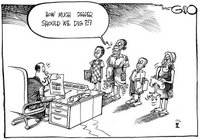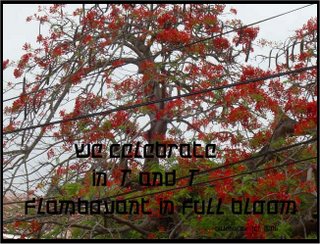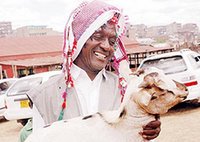:::::::::::::::::::::::::::::::::::::::::::::::::::::::::::::::::::::::::::::::::::::::::::::::::::::
School exams KCSE / KCPE
***** Location: Kenya
***** Season: Short rains (October / November)
***** Category: Humanity
*****************************
Explanation
Every year at the end of October, Kenyan secondary schools close, so as not to disturb the senior students, who are taking the Kenya Certificate of Education (KCSE) exams. Tough national examinations they are -- test papers are written and transported in total secrecy (with occasional lapses, which become national front-page news and are major dramas for those affected). Exam classes are strictly invigilated by teachers from other schools.
Candidates are normally 18 to 20 years old. They take three compulsory subjects, English, Swahili and Mathematics, as well as around four others, chosen by them. Science papers include laboratory experiments, and it is justifiably a constant topic of argument whether this does not put the up-country or urban slum schools at a disadvantage.
Once the KCSE is over, the country immediately switches to the KCPE (Kenya Certificate of Primary Education), taking place in the first half of November. Numbers of students participating have risen hugely, since the government introduced free primary education a couple of years ago, encouraging even adults to return to school. The KCPE takes only three days; the younger classes resume as soon as the exams are over. Subjects taken by the mostly 14 to 16-year-olds are English, Swahili, Mathematics, Insha (Swahili composition), Science, CRE (Christian Religious Education or its Muslim or Hindu equivalents), and a mix of history, geography, civics, environmental studies, etc.
Given the numbers involved (see details below), this double exercise is a major logistic success story and shows the priority which all post-Independence Kenyan governments have attached to education.
The exams are tremendously important to students and parents, as the marks obtained will determine whether a candidate may pass to the next higher level of learning. This photo shows the KCPE candidates from All Saints' Cathedral Primary School, Nairobi, being prayed for on 6 November 2005, one day before the KCPE started :
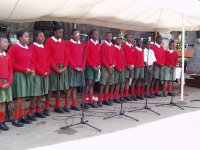
Text and photo (c) Isabelle Prondzynski
xxxxxxxxxxxxxxxxxxxxxxxxxxxxx
The East African Standard (Nairobi)
November 6, 2005
The Kenya Certificate of Primary Education (KCPE) examination gets underway tomorrow. Over 670,000 candidates will sit for the exams in some 18,000 centres countrywide. This morning, the candidates will be taken through a rehearsal session by the supervisors and invigilators.
Tomorrow, the candidates begin with Mathematics, English Language and Composition papers. On Wednesday, they will do Science, Kiswahili Language and Kiswahili Insha. On the last day, they will sit for Geography, History, Civics and Religious Education. The Kenya National Examinations Council secretary, Mr Paul Wasanga, cautioned examination officials against abetting cheating.
http://allafrica.com/stories/200511071132.html
xxxxxxxxxxxxxxxxxxxxxxxxxxxxx

http://www.nationmedia.com/dailynation/images/news/Newins081105.jpg
xxxxxxxxxxxxxxxxxxxxxxxxxxxxx
Prisoners and the elderly sit KCPE exams
Story by NATION Team
Publication Date: 9 November 2005
Millicent Jemtai could not be detered by her illness, as she tackles her Mathematics Paper of this year's Kenya Certificate of Primary Education (KCPE) at Eldoret Hospital yesterday.
Photo by Jared Nyataya.
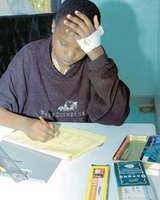
http://www.nationmedia.com/dailynation/images/news/Newsinsa91105.jpg
Death row inmates were among hundreds of thousands of candidates who started their Kenya Certificate of Primary Education (KCPE) exams countrywide yesterday.Ninety four adult education learners, most of old men and women, expressed optimism that they would pass as they started their exams at Nairobi's St Peter's Claver Primary School.
Mrs Dina Masila, 50, a surbodinate staff at the ministry of Health headquarters said: "I want to study up to the university and become a counsellor." Her daughter is also a candidate.

http://www.nationmedia.com/dailynation/images/news/Newsinsb091105.jpg
At Lang'ata Women's Prison, two death row convicts were among nine candidates who sat for the exam at the centre. Three of their colleagues who had registered did not turn up because they were released in August. Only one of them turned up. The acting officer in charge, Mrs Elizabeth Olaba, said the convicts were encouraged to sit their exams by the Government's commitment to abolish the death sentence.
And 30 inmates, 21 of them on death row, are sitting the exams at Naivasha Maximum Prison. Acting officer in charge of the Prison James Mwalo Kodieny said eight inmates who had registered for the exam had completed their jail terms. John Mwangi, 26, a death row inmate, said he was hopeful that the Government would commute his sentence.
Papers arrived early in most schools except in Nyatike division where most roads had been rendered impassable by heavy rains currently pounding the region. Heavy rains also pounded Narok District as 5,739 candidates started the exams. The papers were dispatched to the 246 centres on Monday to avoid vehicles getting stuck while delivering the papers.
Reported by Cyrus Kinyungu, Angwenyi Gichana, Elisha Otieno, Ben Amadala, John Ochieng, Macharia Mwangi, Muchiri Gitonga, Joseph Kimani, Sollo Kiragu, Geoffrey Rono and Dennis Odunga
http://www.nationmedia.com/dailynation/nmgcontententry.asp?category_id=1&newsid=61093
*****************************
Worldwide use
*****************************
Things found on the way
Success Cards
As the Kenya Certificate for Primary Education(KCPE) and Kenya Certificate for Secondary Education(KCSE) approach, vendors start to sell success cards. Muthurwa Hawkers Market has now joined in, together with many other shops and markets.
Success cards have always been a big thing for any primary and secondary school candidate in Kenya. But apart from the encouraging messages they carry, success cards have been used for many other hidden agendas.
They are many different types for different recipients depending with the relationship between the sender and the recipient. There are those that have pictures of animal, nature and prominent people. Then there are those that are designed for lovers with two people cuddling or kissing. Those with sweet melodies and others with lighting words. The messages in them also vary but the central idea has always been to encourage candidates, give them hope and the much needed confidence during their exams.
In schools, pupils and students compete to see who receives many success cards before and during the exam period. There is nothing better to make your morning during an exam period than having your name called to collect a success card during assembly time. The competition gets tough and some students buy success cards and pretend that it is someone else who has sent them the cards, just to remain on top.
Then there are those senders who go an extra mile. Some put sugar particles in your success card to show their love, others enclose a love letter while others add money or gifts to accompany success cards.
It is also a time for embarrasement for those who repeat classes without informing their well wishers or who lie to their friends and relatives about their class levels. When a standard seven pupil, or form two or three student is called to pick up his or her success card, they remain the laughing stalk for the rest of the exam period.
Caleb Mutua
. . . CLICK here for Photos !
*****************************
HAIKU
invigilator
praying for the children --
pens scratch paper
this school uniform --
stained and torn and worn
one more time
Isabelle Prondzynski
xxxxxxxxxxxxxxxxxxxxxxxxxxxxx
mother a wreck
nervous child shivers
with exam fever.
for mere marks
wasting hours
no learning life skills
shoma
http://groups.yahoo.com/group/happyhaiku/message/2351
xxxxxxxxxxxxxxxxxxxxxxxxxxxxx
KCPE results
Wambui joins Moi Girls
Erick Starehe Boys
-- Patrick Wafula
xxxxxxxxxxxxxxxxxxxxxxxxxxxxx
clipboards in hand-
KCSE candidates listen
to their supervisors
the shuffle of papers
the only sound in the room-
KCSE exams
Patrick Wafula, October 2006
:::::::::::::::::::::::::::::::::::::::::::::::::::::::::::::::::::::::::::::::::::::::::::::::::::::
................................... Exam Haiku
Students in numbers
Despite repeated warnings
Leave their cell phones on
http://www.salocin.com/weblog/archives/000161.html
xxxxxxxxxxxxxxxxxxxxxxxxxxxxx
The exam questions
A cat chases butterflies
never catching one
The exam finished
trying to go home I walk
up to a dead end
http://haiku.cc.ehime-u.ac.jp/~shiki/shiki.archive/html/9603/0118.html
*****************************
Related words
***** Exam results (kigo for the hot dry season)
KCPE results are published in January of the following year, leading to a frantic period of activity for secondary schools, as they analyse the results and set the cut-off mark. Students may apply for one school in each of three categories -- national schools (subsidised by the State and taking in the brightest and best of the youth), provincial schools (good secondary schools located within each of the provinces), and local schools. Even to get into a local school is a success, as only about half the KCPE examinees are offered secondary school places at all.
The results of the KCSE are published later. Students have to wait at least from November to September of the following year for their first chance to get into university. University places too are severely limited and highly desirable -- private universities are now springing up, and for students with access to funds or to sponsors, they are a welcome alternative. The children of wealthy families may also look abroad for third-level opportunities.
Isabelle Prondzynski
Read more here :
http://www.vk.co.ke/?no=2532&mk=comment
xxxxxxxxxxxxxxxxxxxxxxxxxxxxxxxxxxxx
Some sponsors have set up private secondary schools, which take in students who did not manage to obtain a place in one of the public schools. One of my favourite private secondary schools is Bahati Community Centre, situated in the slum of Kayole and founded by a small group of young students from Kayole (Nairobi) itself, who felt they had been lucky to get into secondary education, and wanted to share their good fortune with those young people who had not managed (either for lack of points, or for lack of funds to pay school fees).
Bahati is very largely run on a voluntary basis, but students pay a small fee so that teachers can work full-time. The school has no building (it rents an unfinished house), no electricity, no window panes, no water, but a pit latrine and a group of dedicated young teachers and hard-working students.
Read some of their stories here, and see the picture of the very first group of KCSE candidates (who had to sit the exam in a different school, as they were not yet recognised as an exam centre) :
http://www.bahatia.blogspot.com/
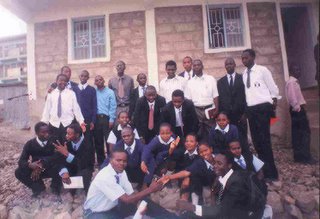
Text and photo (c) Isabelle Prondzynski
BCC's First Kenya Certificate of Secondary Education Candidates (KCSE) 2005.
The first BCC Secondary School K.C.S.E (Kenya Certificate of Secondary Education) candidates : This year, BCC Secondary School is among the Secondary Schools in Kenya that are hosting the Kenya Certificate Of Secondary Examination candidates. The exam commenced on 21st October and will end on 15th November.
To BCC, this is an auspicious and historical moment because these are the first such candidates since its inception 4 years ago. The 23 candidates are among the 260,000 candidates sitting this exam country wide.
http://www.bahatia.blogspot.com/
:::::::::::::::::::::::::::::::::::::::::::::::::::::::::::::::::::::::::::::::::::::::::::::::::::::
KCSE results--
even the school guard joins
the celebrations
KCSE results--
his shaky finger run down
the index numbers
Caleb David Mutua
Kenya, March 2010
:::::::::::::::::::::::::::::::::::::::::::::::::::::::::::::::::::::::::::::::::::::::::::::::::::::
she buys her child
a flowered success card -
KCSE exams
Duncan Omoto
:::::::::::::::::::::::::::::::::::::::::::::::::::::::::::::::::::::::::::::::::::::::::::::::::::::
***** Graduation Ceremony in Kenya :
kigo for short rains
:::::::::::::::::::::::::::::::::::::::::::::::::::::::::::::::::::::::::::::::::::::::::::::::::::::
[ . BACK to WORLDKIGO TOP . ]
:::::::::::::::::::::::::::::::::::::::::::::::::::::::::::::::::::::::::::::::::::::::::::::::::::::



